what ohio counties is ilex opaca native to
By: Kurt Knebusch and Paul Snyder
Plant these for bees, and the holidays this year.
Here'southward vii hollies that can take it when Jack Frost nips at their noses.
They thrive in bleak midwinters. They look good in the mural all year. And you lot can cutting stems from at least iii of them to decorate your habitation for the holidays. And bees beloved them.
How would they await in your garden?
i. Winterberry, Ilex verticillata
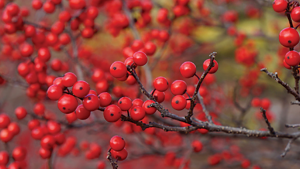
Movie bare grayness stems begetting gleaming carmine berries. That's winterberry, a deciduous holly that, different the evergreen English holly, drops all its leaves before winter.
"This is my favorite species of holly, with the selection Winter Red topping the list, simply for the fact that the stems are admittedly stunning when covered in cherry-red berries," Snyder said.
Winterberry is native from Canada south to Florida, west to Missouri, including in Ohio. Information technology comes in minor and big selections that range from two to x anxiety loftier when fully grown. It prefers damp sites just tin can tolerate drier ones. Birds such as bluebirds eat its berries. And its cutting stems work peachy as natural, colorful holiday decorations.
"It holds up quite well in arrangements," Snyder said. "And it dries well if left undisturbed in a vase."
Detect winterberry in many places in the arboretum's theme gardens.
2. Inkberry, Ilex glabra
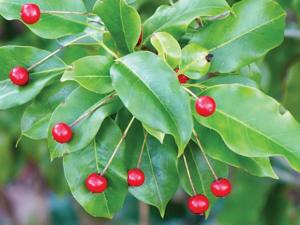
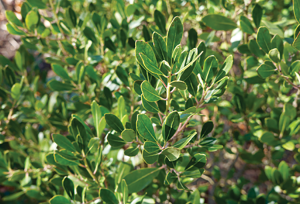
Inkberry, too, is native to much of eastern and central Northward America, but especially pine woods and ocean coasts. Its evergreen leaves are dark-dark-green, obovate – teardrop-shaped – and defective in spines. Its berries, meanwhile, give information technology its name. They're black. Just white-berried types be, likewise.
In the wild, inkberry grows as a dense, rounded shrub. In the landscape, it's a common foundation planting. At the holidays, Snyder said, it's used very piffling for decorating.
Spot inkberries along the arboretum's John Ford Allee and One thousand thousand Bloom Pathway.
3. Longstalk holly, Ilex pedunculosa
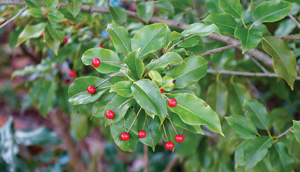 Longstalk holly has night-dark-green, evergreen, spineless leaves and an eventual elevation of nearly 30 anxiety. It makes a good specimen plant in the landscape, Snyder said. Best of all are its glossy ruby-red berries, which, every bit its proper name suggests, are borne on stalks, which are one to two inches in length.
Longstalk holly has night-dark-green, evergreen, spineless leaves and an eventual elevation of nearly 30 anxiety. It makes a good specimen plant in the landscape, Snyder said. Best of all are its glossy ruby-red berries, which, every bit its proper name suggests, are borne on stalks, which are one to two inches in length.
The berries are "quite attractive and stand out from other Ilex species, although the fruit isn't as heavy as other Ilex, " Snyder said. Even so, he added, "It's not widely used in vacation decorating except by plant geeks similar me."
Hunt longstalk hollies in the arboretum's original holly examination planting, which is south of Pine Road and Green Bulldoze, and around the John Streeter Garden Amphitheater.
4. American holly, Ilex opaca
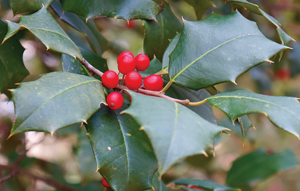 American holly is native from the Northeast s to Florida and west to Missouri and Texas. It grows in the wild in several counties in southern Ohio, Snyder said. Information technology gets to be a pocket-size or medium tree of 40-50 anxiety high. But in the Buckeye State, a superlative of 20-30 feet is more likely, he said.
American holly is native from the Northeast s to Florida and west to Missouri and Texas. It grows in the wild in several counties in southern Ohio, Snyder said. Information technology gets to be a pocket-size or medium tree of 40-50 anxiety high. But in the Buckeye State, a superlative of 20-30 feet is more likely, he said.
"It's dull-growing in Ohio and becomes very graceful – a pyramidal habit – with age," he said. "This plant, in my opinion, is very beautiful and well worth the expect to see a mature specimen in the mural.
"When you come across a large specimen, at that place'southward near a respect for the plant. Information technology'southward a noble tree in its own right considering it took decades to reach such heights."
The leaves of American holly resemble those of English holly. They're glossy light-green with precipitous spines. The institute's berries are red or yellow. It needs moist, well-drained, acidic soil and, ideally, protection from the winter wind so it doesn't become burned and lose leaves.
American holly is a common substitute for English language holly in vacation decorating.
5. Finetooth holly, Ilex serrata
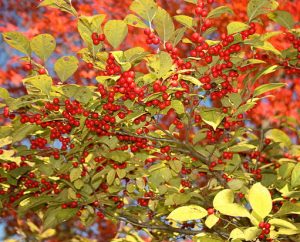 Native to Cathay and Japan, finetooth holly resembles winterberry except for two traits: Its berries are smaller. And it's semi-evergreen, not deciduous. It doesn't drop all its leaves in Fall. Some of them hang on through Winter.
Native to Cathay and Japan, finetooth holly resembles winterberry except for two traits: Its berries are smaller. And it's semi-evergreen, not deciduous. It doesn't drop all its leaves in Fall. Some of them hang on through Winter.
"The berries are bright sleeky red and concord up well equally a cutting branch," Snyder said. "Outdoors, the fruit persist much longer than those of winterberry, making information technology an first-class addition to the Wintertime mural."
But finetooth holly is "not widely used for holiday decorating simply for the fact that it retains some of its foliage; winterberry is the preferred species," he said. "I've used it for decorating merely to run across how many species of Ilex I tin can use."
6. Japanese holly, Ilex crenata
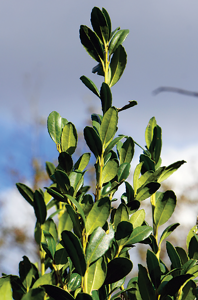 Japanese holly is an evergreen blazon with small, rounded, dark-green leaves and a very dense branching habit. Its berries are black and difficult to run into because of that branching habit. Its foliage and texture resemble those of boxwood. Information technology can be used similar boxwood in wreaths and the like.
Japanese holly is an evergreen blazon with small, rounded, dark-green leaves and a very dense branching habit. Its berries are black and difficult to run into because of that branching habit. Its foliage and texture resemble those of boxwood. Information technology can be used similar boxwood in wreaths and the like.
"Japanese holly will abound in Ohio, simply it's not widely planted," Snyder said. "We've lost several of them in the arboretum over the by couple of years due to different factors. But the selection Sky Pencil performs well here."
Look for Japanese hollies in the arboretum's Jack Miller Discovery Garden.
7. Meserve hybrid hollies, Ilex 10 meserveae
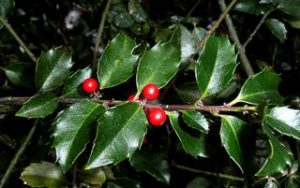 Sleeky, beautiful, evergreen foliage in shades of green or bluish-green, plus glossy brilliant-blood-red berries: That's what y'all get with the Meserve hybrid hollies. They're crosses between tsuru holly, or Ilex rugosa, and English holly. They're widely grown in the landscape, near to the bespeak of overuse, Snyder said.
Sleeky, beautiful, evergreen foliage in shades of green or bluish-green, plus glossy brilliant-blood-red berries: That's what y'all get with the Meserve hybrid hollies. They're crosses between tsuru holly, or Ilex rugosa, and English holly. They're widely grown in the landscape, near to the bespeak of overuse, Snyder said.
Meserve hollies will grow in sunday or partial shade but prefer the latter. Harsh winters can scorch their leaves. "A couple of years agone, many of them were defoliated or killed to the ground during winter," Snyder said.
They smooth when used in decorating, he said, noting they're often preferred over American holly because their leaves are glossier and their spines aren't as sharp.
Find Meserve hollies, also, in the Jack Miller garden.
Call up, it takes two
Come up next Spring, if you lot desire to plant hollies, call up that the entire Ilex genus is dioecious.
"That means that male and female person flowers are borne on divide plants," Snyder said. "And so in order to get berries, you lot need a male pollinator."
Only non just any male pollinator. The male and female person holly plants must belong to the same species, must exist planted somewhat near each other, and must blossom at the same fourth dimension. Garden middle staff and other experts can tell you lot the right pairings and spacings.
Photos 1, 2, 3, 4 and vi taken in Secrest Arboretum, Wooster, Ohio past Mitch Moser, CFAES.
radfordablemplaid.blogspot.com
Source: https://www.beeculture.com/holly-bee/
0 Response to "what ohio counties is ilex opaca native to"
Postar um comentário